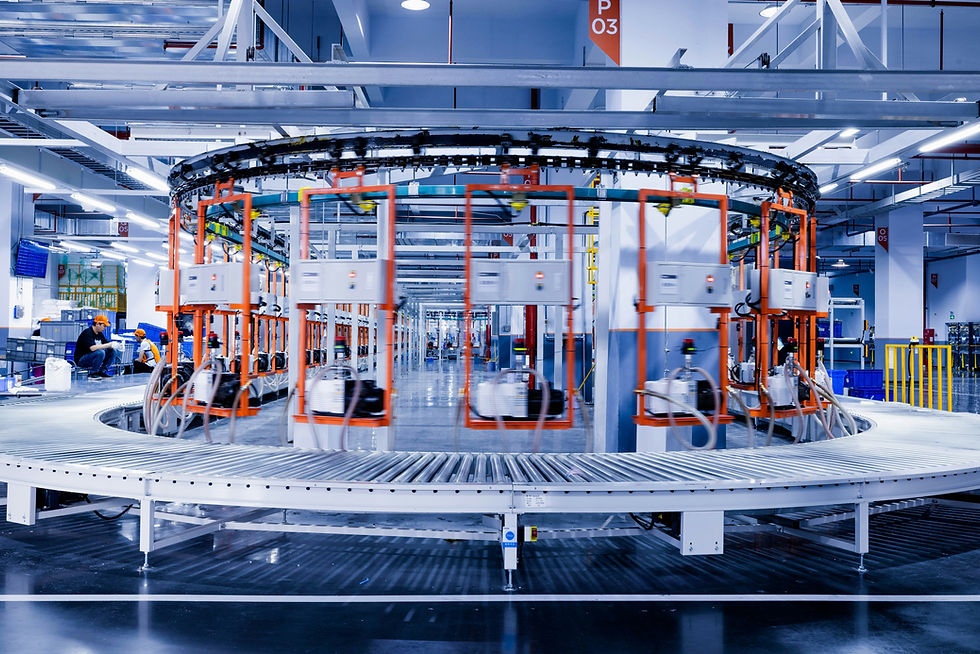🏭 Part 6: Industrial & Mission-Critical IoT – Wireless HART, ISA100, DECT-2020 NR, and TETRA
- Eurth Engineering
- Oct 31
- 4 min read
Most IoT deployments focus on convenience, efficiency, and cost savings. But in industrial and mission-critical environments – oil rigs, chemical plants, power grids, defense, and emergency response – the stakes are much higher.
Here, downtime can cost millions, and failures can risk human lives. These environments demand ultra-reliable communication, deterministic performance, strong security, and resilience to interference.
This is where industrial and mission-critical IoT protocols like Wireless HART, ISA100.11a, DECT-2020 NR, and TETRA/P25 radio with IoT extensions come into play.

🗺️ Why Specialized Industrial IoT Protocols?
Industrial IoT requires much stricter guarantees than consumer IoT:
Determinism: Data packets must arrive within fixed latency budgets.
Resilience: Must operate in noisy environments (chemical plants, refineries).
Safety: Networks often control hazardous processes (gas pipelines, power grids).
Scale: Thousands of sensors per site.
Mobility & Mission-critical: For defense, utilities, and emergency teams.
These protocols are designed to prioritize reliability and safety over speed and cost.
🔑 Key Industrial & Mission-Critical IoT Technologies
1. Wireless HART
Wireless HART is an extension of the HART (Highway Addressable Remote Transducer) protocol used in industrial sensors for decades.
Range: 100 m per hop (mesh extends further).
Power: Low.
Data Rate: 250 kbps.
Topology: Self-organizing mesh.
Special Feature: Time Synchronized Mesh Protocol (TSMP) → deterministic, secure.
Use Cases:
Process industries (oil & gas, chemicals).
Condition monitoring of rotating machinery.
Remote sensor installations in refineries.
Pros:
Built for industrial reliability.
Secure and deterministic.
Mesh networking increases resilience.
Cons:
Limited ecosystem (industrial vendors only).
Higher cost than consumer protocols.
Business Case Example: ExxonMobil uses Wireless HART to connect hundreds of vibration and temperature sensors across refineries, avoiding costly cabling.

2. ISA100.11a
ISA100.11a is another industrial wireless standard, developed by the International Society of Automation.
Range: 100–500 m.
Power: Low.
Data Rate: Up to 250 kbps.
Topology: Mesh.
Special Feature: QoS with configurable latency, redundancy.
Use Cases:
Refinery process automation.
Power plants.
Condition-based maintenance in industrial facilities.
Pros:
Highly configurable.
Interoperability certification.
Deterministic latency.
Cons:
Competes with Wireless HART → fragmented ecosystem.
More complex configuration.
Business Case Example: Petrochemical plants in the Middle East use ISA100.11a for real-time monitoring of pipelines and tanks.

3. DECT-2020 NR
DECT-2020 NR (New Radio) is an ETSI standard designed for industrial IoT at scale. It is sometimes called the 5G for IoT (though technically separate).
Range: 1–5 km.
Power: Low.
Data Rate: ~1 Mbps.
Special Feature: Supports massive IoT with cellular-like scheduling but works in unlicensed spectrum.
Use Cases:
Smart factories.
Industrial IoT campuses.
Utilities with large sensor networks.
Pros:
Massive scalability (millions of devices).
Low latency.
Standardized by ETSI.
Cons:
Very new (ecosystem still developing).
Competes with private 5G in some cases.
Business Case Example: European Industry 4.0 testbeds are piloting DECT-2020 NR as a cost-effective alternative to private 5G for industrial IoT.

4. TETRA and P25 Radios with IoT Extensions
TETRA (Terrestrial Trunked Radio, common in Europe) and P25 (used in the US) are mission-critical communication systems for police, fire, and utilities.
Traditionally designed for voice + low data, they now integrate IoT extensions for telemetry and sensor monitoring.
Range: 1–20 km (depends on infrastructure).
Power: Medium.
Data Rate: kbps range (low, for telemetry).
Use Cases:
Emergency response IoT.
Utility grids.
Defense & public safety IoT.
Pros:
Ultra-reliable in mission-critical conditions.
Operates in dedicated spectrum.
Long-established networks (decades in service).
Cons:
Very low data capacity.
Not suited for rich IoT data (video, AR).
Business Case Example: European fire brigades integrate IoT gas detectors with TETRA radios to provide real-time environmental data to emergency teams.

📊 Comparison Table
Technology | Range | Power | Data Rate | Best Use Cases |
Wireless HART | 100 m (mesh) | Low | 250 kbps | Process industries, refineries |
ISA100.11a | 100–500 m | Low | 250 kbps | Power plants, pipelines |
DECT-2020 NR | 1–5 km | Low | ~1 Mbps | Smart factories, utilities |
TETRA/P25 IoT | 1–20 km | Medium | kbps | Public safety, defense, utilities |
⚖️ Business Cases
Oil & Gas (Wireless HART vs ISA100.11a):Wireless HART provides quick deployments for vibration sensors. ISA100 is chosen where deterministic QoS is critical (pipeline safety).
Smart Factories (DECT-2020 vs Private 5G):DECT-2020 NR offers cost-effective, unlicensed spectrum deployments. Private 5G is better where ultra-low latency (<10 ms) is needed for robotics.
Emergency Response (TETRA IoT vs LTE-M):TETRA ensures reliable comms even when LTE fails. LTE-M provides richer data (video, maps) – both are increasingly used together.
Utilities (DECT-2020 vs LoRaWAN):DECT-2020 scales to millions of devices in dense cities. LoRaWAN is cheaper for rural deployments.
🚀 Future Outlook
Wireless HART & ISA100 will continue powering process industries where safety is paramount.
DECT-2020 NR is expected to grow as a “massive IoT” standard for Industry 4.0.
TETRA/P25 IoT will remain relevant in defense and public safety, but hybrid LTE/5G + TETRA deployments will emerge.
Private 5G + Industrial IoT will increasingly overlap with these specialized protocols, offering richer services but at higher cost.
🏁 Conclusion
Industrial and mission-critical IoT isn’t about speed or convenience – it’s about trust, safety, and resilience. Protocols like Wireless HART and ISA100 ensure that oil refineries and power plants can monitor hazardous processes reliably. DECT-2020 NR promises to scale smart factories into the millions of devices. TETRA and P25 radios continue to safeguard emergency teams while adding IoT telemetry.
The lesson? Industrial IoT requires protocols built for purpose, not adapted from consumer tech. And as factories, utilities, and defense systems modernize, we will see a coexistence of specialized protocols with mainstream ones like private 5G.
Reliability is king – and these protocols are designed with that as their first priority.










Comments